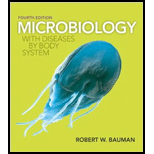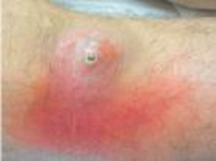
Microbiology with Diseases by Body System (4th Edition)
4th Edition
ISBN: 9780321918550
Author: Robert W. Bauman Ph.D.
Publisher: PEARSON
expand_more
expand_more
format_list_bulleted
Concept explainers
Textbook Question
Chapter 6, Problem 2CCS
Boils in the Locker Room

For several weeks, faculty, students, and staff at Rayburn High School have been dealing with an epidemic of unsightly, painful boils and skin infections. Over 40 athletes have been too sore to play sports, and 13 students have been hospitalized. Nurses take clinical samples of the drainage of the infections from hospitalized students, and medical laboratory scientists culture the samples. Isolated bacterial colonies are circular, convex, and golden. The bacterium is Gram-positive, mesophilic, and facultatively halophilic and can grow with or without oxygen. The cells are spherical and remain attached in clusters.
- 1. What color are the
Gram-stained cells? - 2. What does the term “facultatively halophilic” mean?
- 3. What is the scientific description of the bacterium's oxygen requirement?
- 4. If the bacterium divides every 30 minutes under laboratory conditions, how many cells would there be in a colony after 24 hours?
Expert Solution & Answer
Want to see the full answer?
Check out a sample textbook solution
Students have asked these similar questions
Describe the levels of structural hierarchy for the human body, starting with the organismal level and ending with the chemical level. In addition, you should make sure you link each level to the previous level, emphasizing the structural relationships.
9
S
es
Read the section "Investigating Life: In (Extremely) Cold Blood." Then, drag and drop the terms on the left to complete the concept
map.
Red blood cells
Genes
Icefishes
-have mutated
have colorless
Oxygen
have few
lack
encode
Blood
Cellular
respiration
consists of-
contain
carries
is a
Platelets
White blood
cells
carries
low
amounts
of
Hemoglobin
is necessary for
Plasma
Protein
Reset.
Plating 50 microliters of a sample diluted by a factor of 10-6 produced 91 colonies. What was the originalcell density (CFU/ml) in the sample?
Chapter 6 Solutions
Microbiology with Diseases by Body System (4th Edition)
Ch. 6 - Why should cardiac nurses and respiratory...Ch. 6 - Cavities Gone Wild Five-year-old Daniel appears to...Ch. 6 - Why do clinical laboratory scientists keep many...Ch. 6 - Boils in the Locker Room For several weeks,...Ch. 6 - Some students transfer some gunk from a 2-week-old...Ch. 6 - Which of the following can grow in a Petri plate...Ch. 6 - In the laboratory, a sterile inoculating loop is...Ch. 6 - Superoxide dismutase _____________. a. causes...Ch. 6 - The most reactive of the four toxic forms of...Ch. 6 - Microaerophiles that grow best with a high...
Ch. 6 - Prob. 6MCCh. 6 - Organisms that preferentially may thrive in icy...Ch. 6 - Prob. 8MCCh. 6 - Which of the following terms best describes an...Ch. 6 - In a defined medium, ______________. a. the exact...Ch. 6 - Which of the following is most useful in...Ch. 6 - Which of the following methods is best for...Ch. 6 - A Coulter counter is a(n) ________________. a....Ch. 6 - Lyophilization can be described as ___________. a....Ch. 6 - Quorum sensing is _____________. a. the ability to...Ch. 6 - Prob. 1FIBCh. 6 - Prob. 2FIBCh. 6 - Prob. 3FIBCh. 6 - Prob. 4FIBCh. 6 - Prob. 5FIBCh. 6 - Fill in the Blanks 6. Cells that shrink in...Ch. 6 - Fill in the Blanks 7. Obligate ________ exist in...Ch. 6 - Prob. 8FIBCh. 6 - Fill in the Blanks 9. Microbes that reduce N2 to...Ch. 6 - Fill in the Blanks 10. A student observes a...Ch. 6 - Fill in the Blanks 11. Chemolithotrophs acquire...Ch. 6 - Prob. 1VICh. 6 - Prob. 2VICh. 6 - High temperature affects the shape of particular...Ch. 6 - Support or refute the following statement:...Ch. 6 - Explain quorum sensing, and describe how it is...Ch. 6 - Why must media, vessels, and instruments be...Ch. 6 - Why is agar used in microbiology?Ch. 6 - What is the difference between complex media and...Ch. 6 - Draw and label the four distinct phases of a...Ch. 6 - If there are 47 cells in 1 l of sewage, how many...Ch. 6 - Prob. 9SACh. 6 - Prob. 10SACh. 6 - Explain the differences among photoautotrophs,...Ch. 6 - Contrast the media described in Tables 6.3 and 6.4...Ch. 6 - How does a chemostat maintain a constant...Ch. 6 - A scientist describes an organism as a...Ch. 6 - Pasteurization is a technique that uses...Ch. 6 - Two cultures of a facultative anaerobe are grown...Ch. 6 - Some organisms require riboflavin (vitamin B2) to...Ch. 6 - A scientist inoculates a bacterium into a complex...Ch. 6 - How can regions within biofilms differ in their...Ch. 6 - A scientific article describes a bacterium as an...Ch. 6 - Prob. 8CTCh. 6 - Prob. 9CTCh. 6 - Starting with 10 bacterial cells per milliliter in...Ch. 6 - Suppose you perform a serial dilution of 0.1-ml...Ch. 6 - How might the study of biofilms benefit humans?Ch. 6 - The filamentous bacterium Beggiatoa gets its...Ch. 6 - Given that Haemophilus ducreyi is a...Ch. 6 - Examine the graph in Figure 6.3. Note that the...Ch. 6 - Prob. 16CTCh. 6 - Using the terms in Figure 6.8a, describe the...Ch. 6 - Prob. 18CTCh. 6 - Prob. 19CTCh. 6 - Prob. 20CTCh. 6 - Prob. 21CTCh. 6 - Prob. 22CTCh. 6 - Viable plate counts are used to estimate...Ch. 6 - Prob. 1CM
Knowledge Booster
Learn more about
Need a deep-dive on the concept behind this application? Look no further. Learn more about this topic, biology and related others by exploring similar questions and additional content below.Similar questions
- Every tutor here has got this wrong, don't copy off them.arrow_forwardSuppose that the population from question #1 (data is in table below) is experiencing inbreeding depression (F=.25) (and no longer experiencing natural selection). Calculate the new expected genotype frequencies (f) in this population after one round of inbreeding. Please round to 3 decimal places. Genotype Adh Adh Number of Flies 595 Adh Adh 310 Adhs Adhs 95 Total 1000 fladh Adh- flAdn Adh fAdhs Adharrow_forwardWhich of the following best describes why it is difficult to develop antiviral drugs? Explain why. A. antiviral drugs are very difficult to develop andhave no side effects B. viruses are difficult to target because they usethe host cell’s enzymes and ribosomes tometabolize and replicate C. viruses are too small to be targeted by drugs D. viral infections usually clear up on their ownwith no problemsarrow_forward
- This question has 3 parts (A, B, & C), and is under the subject of Nutrition. Thank you!arrow_forwardThey got this question wrong the 2 previous times I uploaded it here, please make sure it's correvct this time.arrow_forwardThis question has multiple parts (A, B & C), and under the subject of Nutrition. Thank you!arrow_forward
- Calculate the CFU/ml of a urine sample if 138 E. coli colonies were counted on a Nutrient Agar Plate when0.5 mls were plated on the NA plate from a 10-9 dilution tube. You must highlight and express your answerin scientific notatioarrow_forwardDon't copy off the other answer if there is anyarrow_forwardAnswerarrow_forward
- HAND DRAW There should be two proarrow_forwardMolecular Biology Question. Please help solve. Thanks. Please draw how two nucleotide triphosphates are linked together to form a dinucleotide, and label the 5' and 3' ends of the resulting dinucleotide.arrow_forwardWhat is a reversion in molecular biology?arrow_forward
arrow_back_ios
SEE MORE QUESTIONS
arrow_forward_ios
Recommended textbooks for you
- Basic Clinical Lab Competencies for Respiratory C...NursingISBN:9781285244662Author:WhitePublisher:Cengage
 Biology 2eBiologyISBN:9781947172517Author:Matthew Douglas, Jung Choi, Mary Ann ClarkPublisher:OpenStax
Biology 2eBiologyISBN:9781947172517Author:Matthew Douglas, Jung Choi, Mary Ann ClarkPublisher:OpenStax Medical Terminology for Health Professions, Spira...Health & NutritionISBN:9781305634350Author:Ann Ehrlich, Carol L. Schroeder, Laura Ehrlich, Katrina A. SchroederPublisher:Cengage Learning
Medical Terminology for Health Professions, Spira...Health & NutritionISBN:9781305634350Author:Ann Ehrlich, Carol L. Schroeder, Laura Ehrlich, Katrina A. SchroederPublisher:Cengage Learning



Basic Clinical Lab Competencies for Respiratory C...
Nursing
ISBN:9781285244662
Author:White
Publisher:Cengage

Biology 2e
Biology
ISBN:9781947172517
Author:Matthew Douglas, Jung Choi, Mary Ann Clark
Publisher:OpenStax


Medical Terminology for Health Professions, Spira...
Health & Nutrition
ISBN:9781305634350
Author:Ann Ehrlich, Carol L. Schroeder, Laura Ehrlich, Katrina A. Schroeder
Publisher:Cengage Learning
Bacterial Structure and Functions; Author: Osmosis;https://www.youtube.com/watch?v=b15Hy3jCPDs;License: Standard youtube license